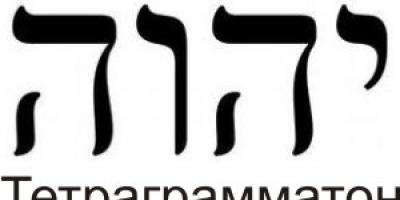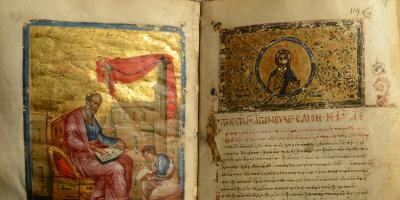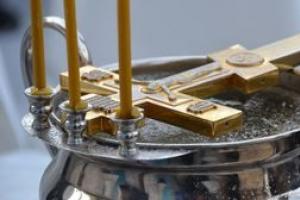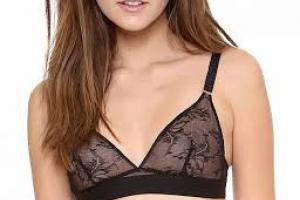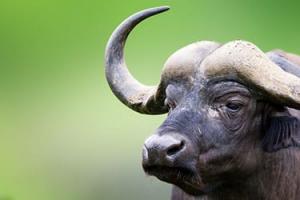In the sixth lesson we will complete
constructive drawing of a frying pan in a complex turn, a fork and a bottle.
Explanations require the construction of a frying pan and a fork.
Building a frying pan.
The frying pan is basically a truncated cone, just like the coffee pot. But in a truncated cone of a frying pan, the size of the rotation axis is so small that it is impossible to determine its direction. We will use the directions of the major axes, which can be determined by the intersection points of the ellipses of the bottom and edge of the pan. If these two points are connected by a straight line, then this straight line will be parallel to the major axes of the ellipses of the bottom and edge of the frying pan, but not identical to these axes.
 Find the dimensions of the frying pan without including the handle. We mark the dimensions of the larger ellipse - the ellipse of the edge of the frying pan. We divide the rectangle of the dimensions of the larger ellipse in half vertically and horizontally. Through the center thus obtained, we construct the major axis of the ellipse of the edge of the frying pan, the direction of which we found from the points of intersection of the ellipses of the bottom and edge in nature.
Find the dimensions of the frying pan without including the handle. We mark the dimensions of the larger ellipse - the ellipse of the edge of the frying pan. We divide the rectangle of the dimensions of the larger ellipse in half vertically and horizontally. Through the center thus obtained, we construct the major axis of the ellipse of the edge of the frying pan, the direction of which we found from the points of intersection of the ellipses of the bottom and edge in nature.
Perpendicular to the major axis we build a minor one through the same center. We fit the ellipse into the dimensions in accordance with the directions of the axes.
 |
 |
If yes, then we build the width of the handle, having first found out where the handle ends.
If not, then adjust the direction of the middle line of the handle, then do the same as in the first case. The directions of the communication lines along which the symmetrical points marking the width of the handle are constructed will in any case be parallel to the tangent to the ellipse of the edges at the point of its intersection with the plane of symmetry or, in other words, at the point of the middle of the handle's entry.
In the frying pan and the neck of the bottle we will add the so-called thickness. Please note that these will be ellipses with common axes, equal proportions, but different sizes. The thicknesses will be greater along the major axes than along the minor axes. Small ellipses can be drawn in the same way as short lines - with emphasis on the little finger.
Building a fork.
The fork is a body of bilateral symmetry and is in an arbitrary rotation.
First, we build the center line of the fork along the directions (the trace of the section of the fork by the plane of symmetry).
In synergetics, a classic example of the organization of ordered structures is Benard cells. They arise in a layer of viscous liquid heated from below. With a large temperature difference, the thinner and therefore lighter liquid below tends to exchange places with the colder surface. This gravitational instability leads to the formation of convective cells. In the literature, the description of the process of the appearance of Benard cells is often given in the following form: “In order to experimentally study the structures, it is enough to have a frying pan, a little oil and some fine powder so that the movement of the liquid is noticeable. If the bottom of the frying pan is flat and we heat it evenly, then we can assume that constant temperatures are maintained at the bottom and on the surface. As long as the temperature difference is small, the liquid is motionless. We will gradually increase the temperature. As soon as the temperature difference at the base and the surface of the liquid exceeds a certain critical value, depending on the properties of the liquid and its depth, the entire medium is divided into regular hexagonal cells, in the center of each of them the liquid moves up, and down along the edges. If you shake the frying pan, thereby destroying the cells, the previous picture will be restored very quickly.”
You noticed that the formulation of the problem in the experiment just described is similar to the formulation of the problem of cracking among permafrost scientists - a homogeneous medium is specified (assumed). Under such conditions, the temperature difference will reach a critical value throughout the entire space simultaneously, and convective cells should appear everywhere in random places, but they are mobile, and therefore, under homogeneous conditions, a strictly ordered pattern can form. But it is impossible to create uniform conditions in a frying pan, it is very difficult to create uniform heating, it is no less difficult to ensure a uniform thin layer of liquid, and the magnitude of the critical temperature gradient at which cells appear, in accordance with the Rayleigh number, depends on the thickness of the liquid layer to the fourth power. In reality, everything is more complicated, and if you want to carry out this experiment as it was just described, i.e. in a frying pan, then you will not get regular hexagons, and every time you shake the frying pan, new patterns will appear.
Let's speculate. Let's consider this option: let the temperature gradient in the frying pan be less than critical everywhere. In a small point area, we increase the heating so that the temperature gradient here reaches a critical value, then an upward flow of heated liquid is formed above this point, and around it a downward annular flow is formed: one elementary convective cell is formed (for convective cells, the horizontal size is comparable to the thickness of the liquid layer). Powder grains scattered along the bottom of the frying pan will be carried away by the bottom flow of liquid to the center of the upward flow, and here these grains will gather into a small tubercle. In the new version, we set that the heating of the pan is uneven, it is maximum in the center, and gradually decreases towards the edges. In this situation, with a general increase in heating, the first cell should appear in the center (at the top of the potential relief cone), the subsequent ones along its perimeter, etc.
Now imagine that everywhere in the frying pan the temperature gradient is slightly less than critical, but in some place a single cell has appeared due to local heterogeneity. This cell in the adjacent area disrupts the stratification of the liquid, i.e. it creates heterogeneity and this can provoke the appearance of new cells nearby (liquid circulation in the first cell will cause circulation in its surroundings). These cells, in turn, will trigger the appearance of the next ones. As a result, the entire space will be covered with cells.
Self-amplification of the potential in the environment of the first cell can occur due to the downward flow of this cell. This flow turns not only towards the center of the first cell, but partially also in its surroundings, causing new upward flows. But another mechanism is also possible.
Convection begins with the appearance of a small tubercle “on the surface” of the lower light layer of liquid. The tubercle, being a heterogeneity, provokes a rise in the light liquid surrounding it - it tends to expand. But for its growth, it must attract light liquid to itself and thereby reduce the thickness of its layer around it, thereby preventing its expansion. While the tubercle is small (has a small radius), the expansion process predominates. Now imagine that the primary tubercle accidentally has an elongated shape in plan. In this case, its narrow ends will actively provoke the rise of light matter near them. The radius of curvature of the tubercle here is small, so the thinning of the light layer in this place is also small, and this should not prevent the substance from rising at the narrow edge of the elongated tubercle. Due to this effect, the primary tubercle can actively stretch. As a result, a fold (ridge) growing in length will be formed in the relief of the “surface” of the lower light layer, surrounded by deflections parallel to it. The ends of this ridge should lengthen in the direction in which the state of the environment is closer to critical. The development of linear elements with such a scheme should be similar to the development of folds in a compressed-stressed elastic layer.
The upward flow of material along this ridge may become unstable. At some point on the ridge, the speed of fluid movement may be slightly higher. To do this, an additional influx of warm bottom matter is needed here, but its quantity is limited, so the appearance of a peak creates two saddles nearby on the ridge and, accordingly, two new peaks. Their formation will also be associated with the compensatory activation of downward flows of heavy matter surrounding the first peak.
Now, after these preliminary considerations, let's move on to the experiment with a frying pan. You can take any oil (as long as it doesn’t splatter), and you can use flour as a powder (heavier powders will lie motionless at the bottom). It is better to take an aluminum frying pan - the patterns made from dark fried flour are more visible against the light background of the frying pan. It is better to pour the oil in a layer of 2-3 mm; the thinner the layer, the brighter the pattern and larger number cells. It is better to take the smallest frying pan - from the children's set (if large sizes it is difficult to maintain the uniform thickness of the oil layer and it is difficult to look at the entire pattern). Before each installation of the pan on the tile, the flour must be distributed evenly over the entire surface. This may be the most difficult part of the experiment. You can smooth the flour with a brush, or you can tilt or move the pan sharply, creating a flow of oil.
So, a frying pan on a hot stove. In all experiments you will clearly see the effect of a shifting boundary of structure formation. Originating in the area of greatest heating (at the point of closest contact with the plate), the pattern expands throughout the entire space. Under the most uniform heating conditions, this takes one to three seconds. If you set a high lateral gradient (for example, place the frying pan on the stove with only one edge, and rest the other on something so that most of the pan was not above the stove), it will take 30-60 seconds. In addition to the lateral temperature gradient, the effect of a shifting boundary is determined by the uneven thickness of the oil layer. With relatively uniform heating, the first elements appear where it is thinner, since the vertical temperature gradient is higher here. The appearance of a pattern most often begins with the appearance of linear elements. At the bottom, under the extended ridges of upward flows, due to the powder being pulled here, faint dark stripes appear; they run along the bottom of the frying pan, like cracks. These stripes immediately break as they move, turning into a chain of dots. Most often, linear elements and chains form differently oriented series of several parallel lines. They are often oriented parallel to the edge of the pan.
The orientation of stripes and chains of dots is associated with inhomogeneities in the distribution of flour particles. When they are mixed, banding is formed at the bottom, even if almost imperceptible, and convective shafts run along these bands. The direction of convective shafts is also affected by the orientation of flour particles. It is enough to slightly tilt the pan several times in any direction, so that the powder moves back and forth along the bottom, and dark streaks will appear in the same direction.
Over time, the original pattern is rearranged, and one can see the orientation associated with macro-flows of the liquid. If the heating of the pan is uneven, then in the zone of greatest heating the volume of the substance increases, all the liquid here rises and a tilt is created towards the less heated part. Because of this, the liquid begins to move. In the simplest version, from a very heated edge it moves in a straight line to the opposite one, where the flow bifurcates and returns along the walls of the frying pan. If the bottom of the frying pan were perfectly flat and the oil was clean, then the convective cells would move along with this flow. But the cells themselves create an uneven temperature at the bottom of the pan; under the rising flow it is higher. In our experiment, in addition, a tubercle of flour is formed in the center of each cell, and it is difficult for the cell to move relative to this place; it is “tied” to this tubercle.
In the absence of a general flow in the liquid, the ascending and descending flows in the cell are vertical, but if a flow arises, then these flows tilt and are carried away by the current. The vertical flow in the cell, rising to the surface, diverges in all directions and tends to immediately descend. But that part of the flow that went downstream cannot go down, because it was carried away and the vertical flow of another cell appeared under it. And that part of the flow that went upstream cannot go down, because it was also carried away and the vertical note of its own cell is reflected under it. And only streams diverging to the sides can descend. As a result, the downward flows between the cells in the direction of the flow degenerate, and the system of convective cells is slowly reconstructed into a system of shafts oriented along the flow - a striped pattern appears (Fig. 128, a).
Note that the macroflow velocity on the surface in such an experiment never exceeds 1 mm/s. Along with the stripes, in areas of the pan where there are no strong currents, there may be areas covered with dots (see Fig. 128, b).
As we see, the development of convective structures is also determined by the features of the potential relief and the anisotropic properties of the potential.
If the powder particles are very small, then thin lines can be seen on the pan, marking a hexagonal network of downward flows around these points. But these hexagons will most often be irregular, and they may have not six angles, but five, four or three.
In the experiment with oil and flour, the network of downward flows is poorly visible. But if you take a larger frying pan and heat the wax in it, and then remove it from the heat and let it cool slowly, then over time the surface of the wax will harden, and the wax will first of all harden above the downward flows of convective cells. As a result, a network of veins will be formed, very similar to a network of cracks. The slightest anisotropy is enough, and subparallel main veins will immediately reveal it. In Fig. 129, and shows the structure that appeared when the wax hardened in a small frying pan (wax layer 2 cm), and in Fig. 129, b - central fragment of the structure in a large basin with a wax layer of 4 cm. Anisotropy associated with the edge effect was absent in this place. Here the question arises: what abstract scheme should be used to describe the formation of convective patterns - pointwise or linear?
The frying pan can also be used to model current ripple patterns. Pour water into it and scatter light powder along the bottom. If the frying pan is white, then it is better to take fine charcoal powder, if it is black, use flour. If you start to swing the pan a little from one edge to the other, then alternating flows will appear. As soon as their speed reaches a certain critical value, the powder particles lying at the bottom will begin to move and immediately begin to condense into small short strips oriented across the flow. This is due to the fact that average speed the bottom current running onto an obstacle is higher in front of it than behind it. The tubercle slows down the flow. As a result, the average speed of powder particles when moving towards an obstacle is higher than the speed of moving away from it. As a result, the resulting alternating motion of particles is directed towards their primary small cluster. The highest flow speeds are observed in the center of the pan, so the first elements will begin to appear here. As flow speeds increase, the pattern will expand. The strips will lengthen, compete for powder particles scattered along the bottom, some of them will be absorbed by larger ones, and soon a system of subparallel ridges oriented across the flow will form (note that strictly parallel ridges crossing the entire space can appear only in a rectangular dishes).

You can specify a different flow field. For example, use a large spoon to swirl the water around, pressing it onto the surface of the water in the center of the pan. Then a pattern of ridges will appear, arranged in concentric circles around the center of the pan. (In order to form a pattern, it is not necessary to rock the pan all the time. It is enough to swing the water once, and the pattern will have time to form while the vibrations are damping.)
The considered drawings appeared in a sharply anisotropic field - particles move along the bottom only along one direction. But you can also specify an isotropic velocity field, in which the particles are equally displaced in all directions. To do this, without changing the orientation of the frying pan, move it in a circle so that the particles on the bottom make circular horizontal movements, and then you will see a honeycomb pattern on the bottom of the frying pan.
In conclusion, for independent analysis - another “frying pan” drawing. Grease a heated frying pan with oil, pour a thin layer of dough onto it and observe the holes appearing on the surface. Don't forget to turn it over in time and look at the pancake from the other side.
| <<< Назад
|
Forward >>> |
Good afternoon - today I start new series of articles on crafts for the kitchen... We will start with the simplest idea - and today we will paint frying pans. Moreover, this is an excellent opportunity to extend the life of a burnt-out frying pan with a damaged Teflon coating. This used frying pan can be used as a kitchen decoration. Beautiful craft for the kitchen it can hang separately on the wall... or you can surround it with a flock of... you can beautifully decorate such a wall by nailing narrow shelves next to it and placing ceramics and frames. I've prepared a few ideas interesting crafts– which will decorate the walls of your kitchen. Let's start doing original crafts for the kitchen with your own hands.
Let's, to make things interesting right away I'll show you 3 ideas painting a frying pan with a picture of a woman's head. Let's start with ideas for high-tech kitchens...
Here is a craft idea for a blue kitchen…. Careless graphics with rough strokes... It’s hard to call this a craft made from a frying pan.- This is already a work of art.

Or here’s an idea for a craft for the kitchen in lilac tones... A schematic, laconic technique... an outline outline. Clear smooth lines, pure rich colors. This frying pan will become an eye-catching decoration on the kitchen wall...

If our kitchen is cozy classic style– then a female head in the spirit of the same times will suit us... Like in the photo below - a Greek woman’s head with curls of hair intertwines perfectly with the same smooth curls on kitchen facades from the same light shade as the portrait itself. This frying pan craft can become a rare decoration on the wall of any kitchen.

Here is another theme for wall decoration. Crockery theme... Endless scope for imagination. If you have a kitchen in beige and chocolate tones, then the pattern on the frying pan may be similar to Tarin graphics made with chocolate outline on an aged beige-bluish background.
I'm already specially selecting a series of such ideas for kitchen crafts in a dish theme made from old frying pans.
Crafts and drawings
from an old frying pan for a beige kitchen...
Often beige tones in the kitchen are combined with a soft blue color scheme... and then the pattern on the pan can be done in the same colors... Ideas for thematic drawings can be found on the Internet and painted in exactly the same colors as the kitchen... That’s how it was born idea with this bird– delicate pattern and delicate color.

Or beige color in the kitchen it is often combined with contrasting bright red... And then these same tones will be asked to decorate the wall - and then you can use them in a simple drawing on a frying pan...
Agree, even a child can draw such curlicues of flowers and butterflies. Simple craft for a kitchen that can be done by the whole family.

And if you want to give such a frying pan as a gift? to my newlywed friends– then let the wall be decorated with a beautiful wedding motif... Here is a ready-made idea for decoration beige kitchen...

Or these simple stencil ideas for crafts for the kitchen... the contours of the newlyweds don’t even have to be drawn - you can simply cut them out of black adhesive film... and stick them on a frying pan... (we first paint the frying pan white)

And here ideas are in love x in white, black and red colors. Choose any sweet couple and draw a craft for the kitchen on a white background of a frying pan for your own pleasure. The frying pans will become unusable one after another and over time the walls of your kitchen will be covered with a whole row of frying pans with happy inseparable ones.
And of course, such craft pans can be given to friends on Valentine’s Day...
Frying pans on the kitchen wall - for Valentine's Day
And this is where you can show your imagination by digging through the RuNet and finding ideas for kitchen crafts among ordinary pictures or postcards.

Or a heart of flowers... It will amazingly decorate the kitchen wall in pink tones... And if your kitchen is not pink, then you can decorate the flowers in other colors.
Even a black bouquet against the background of the white surface of a frying pan will look amazing and stylish... especially if your kitchen already has a black hood... or a black marble countertop...
Crafts for the kitchen
frying pan for birthday.
Any motive with greeting card can be transferred to the bottom of the pan. And turn it into a wonderful DIY gift for your birthday.

Bright ideas for
GOOD MOOD
And if you want to really add to the kitchen bright spots...that can be done a whole series of decorated frying pans with steaming cups of cappuccino. Decorated with such frying pans, the walls of your kitchen will make your mouth water and your stomach rumble... Beautiful crafts
Men's gift
from an old frying pan.
But this idea of a painted frying pan with a banknote will also please the owner of a bachelor’s kitchen... A cool idea as a gift for a guy... and if he also works in a bank or finance... then it will come in handy.

We decorate the kitchen walls with a Khokhloma frying pan.

It is better to paint such a design on a black frying pan - that is, cover the entire frying pan with black paint and after the paint has dried, draw the pattern.
You can drill a hole in the center of a painted frying pan and glue a clock mechanism to the bottom (get it from an old watch or buy it at a craft and hand-made store - it’s cheap).

Still life on a frying pan...
You can draw such a still life yourself... or do it using the decoupage technique... In the next article we will already make DECORATION OF FANS using the decoupage method.

Landscape - in a frying pan.
Landscapes are generally easy to paint... you brush a brush here and there, and if something doesn’t work out... it’s no big deal... nature can also have dented grass and crooked trees...
Chicken themed painting on frying pans
Laying hens and loud-voiced cockerels - these are very cozy pictures...
And where there are plump chicken legs, the pink, plump cheeks of a baker will fit in well...



Here are some ideas for crafts for the kitchen.
And that is not all…)))
For everyone who loves France...
I made a selection ideas for frying pans for the kitchen wall in the theme of the beautiful EIFFEL TOWER …
(10 color designs kitchens and 10 eiffel towers on frying pans) you won’t find this anywhere else... I spent half a day digging to make such a selection. And I’m terribly pleased with the result. Ready ideas- take it and implement it.
Good luck with your creativity.
Olga Klishevskaya, especially for the site

